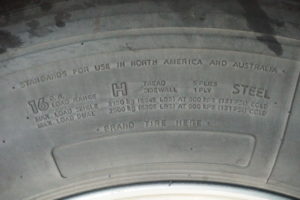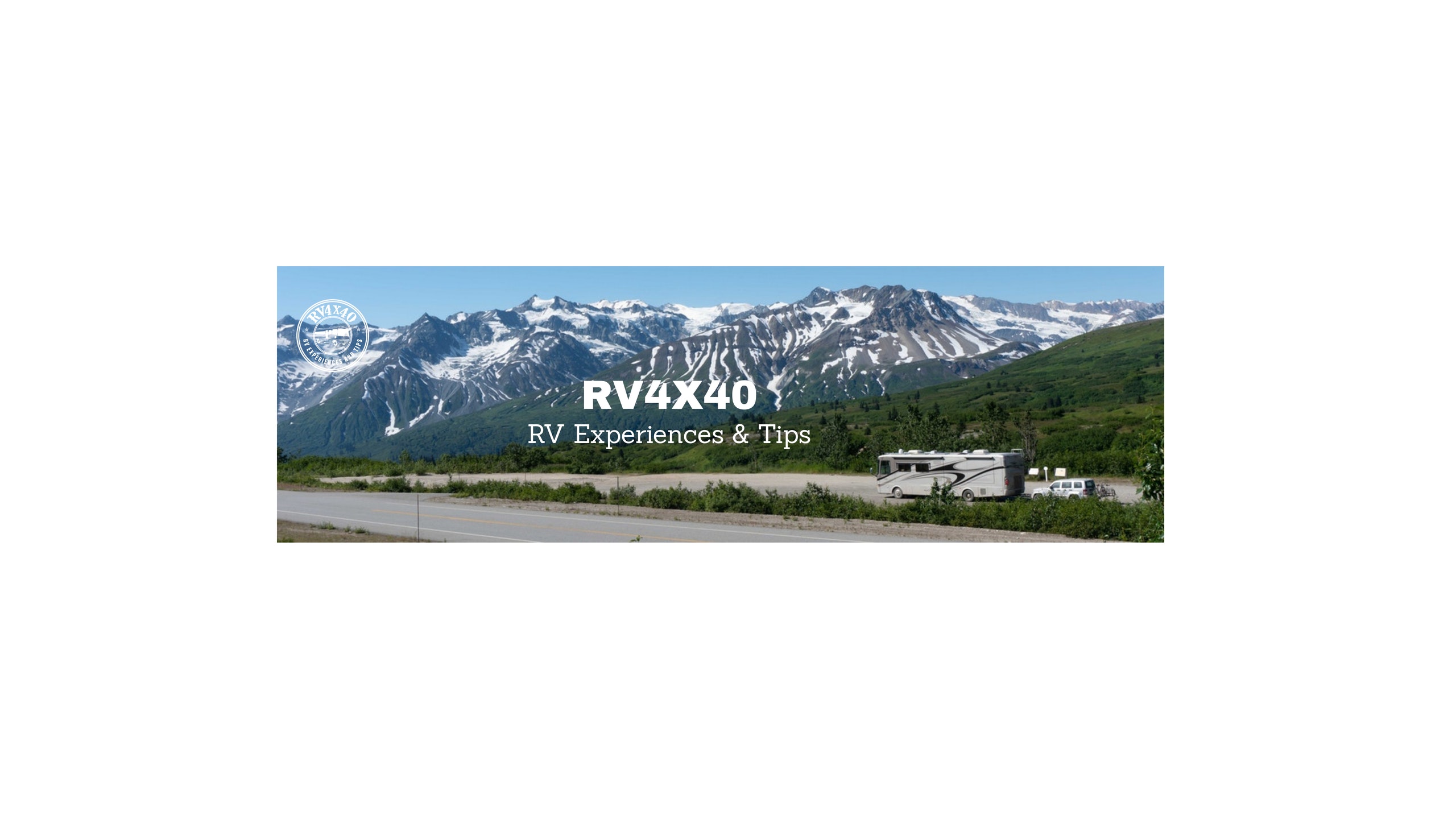Viair 400P-RV
The Viair 400P is an air compressor designed for vehicle use. It features a high working pressure (150 psi) with good volume (2.3 CFM), operation from 12 VDC, and an automatic shutoff to keep the compressor from running continuously. It is designed to run at no more than a 33% duty cycle at no more than 20 minutes of run time, which generally isn’t a problem when using it to top off tires. There is another model, the 450P which is lower air flow (1.8 CFM) and is designed to run continuously at 100 PSI for up to an hour. We’ve done a video review of the compressor on YouTube and you can see the video here:
Air service used to be free at “gas stations”. But back then, they also pumped the gas, cleaned the windows, and checked the oil, too. Now there is often a charge for air and it is usually not at all easy to get an RV into the spots where they have the air fill station. Plus, many stations are oriented to cars only and the system may not have enough pressure to even add air to an RV tire, particularly on a motorhome.
Another issue is that tire pressure is best set with the tires cold. Driving even a few miles to get air can significantly heat the tires and require higher pressure than the cold settings but figuring out how much higher is difficult. It is much more convenient to have a compressor which can adequately provide the correct pressure to even high pressure tires (100 psi or more) right at your fingertips.
Both compressors come in an “RV” model, which adds accessories specifically for putting air in RV tires. The accessory I use most often is the style that screws onto the tire valve so that it isn’t necessary to hold a fitting against a high pressure tire. The other fitting for the tire valve is a long, angled affair that can be pressed onto the valve, but must be held in place while filling the tire. The RV model also includes two 30 ft. coiled hoses for a total of 60 feet of reach, a heavy duty carrying case, and a control “gun” to start the airflow that also has a release valve if you need to reduce the tire pressure, and a large gauge.
The complete kit contents are shown in this photo of the 400P RV model package.

Viair 400P-RV Air Compressor System
A heavy connection is needed to a 12 volt power source. The unit can pull up to 30 Amps so any losses could affect its performance. It comes with two heavy duty spring clamps and the wiring is fused at 40 Amps. I normally hook this to the house batteries, although either the house or vehicle batteries would work. By using both air hoses I am able to reach all four corners of the RV without any problem. The hoses are coiled which is necessary to put them into the carrying case. That also helps keep them somewhat out of the way when using them.
Everything snaps together with standard quick connect air hose fittings. I added a small “blow off” nozzle with the same fitting. This is useful for things like blowing dirt out of air conditioning coils. The fittings require the user to pull back the retaining collar in order to insert or remove the mating fitting. This is easily done with one hand so assembling the system is a snap.
One end of each hose is fitted with an additional strain relief over the fittings. One is used at the compressor end and the other at the tire end of the hoses. These extra strain reliefs help prevent kinking the hoses at either end and is another sign of the quality of the product.
After everything is connected together, except attaching the end fitting to the tire, turn the power on. The compressor will run briefly while it fills the hoses with air and gets the pressure up to over 150 psi. At that point, the compressor will automatically turn off until you use the compressor to add air to a tire. It will then run while you are taking air out of the system because of the reduced pressure. Once you stop filling the tire, the compressor can build the pressure back up in the hoses and the compressor stops. That reduces the on time of the compressor (remember the 33% duty cycle limitation) unless you are actively filling a tire.
Connect the working end to the tire and you will immediately see the pressure in the tire. If you need to add air, simply pull the trigger and you will see the pressure jump up. At this point it will take a few seconds for the compressor to start. That time is while the pressure in the hose drops low enough to trigger the circuit. As you are filling the tire, the pressure indicated on the gauge will be a few pounds higher than what is actually in the tire due to the pressure drop between the gauge and the tire. Release the trigger and the gauge will indicate the real pressure in the tire. When you have it correct, simply remove the fitting from the tire valve and go to the next tire with the pump nicely silent.
If you over shoot the desired pressure, there is a pressure relief valve right on the control gun. Simply push that to release air and drop the pressure back to the desired reading. With this system, maintaining the proper pressure in your tires is easy and relatively stress free.
A side note is in order about RV tire pressure, or truck tire pressure in general. While automotive tires are marked on the sidewall with a maximum allowed pressure and a recommended pressure is marked on the vehicle, heavy duty tires are not marked that way. In fact, they are marked with a minimum pressure.

Tire Pressure Markings
You can see two markings for pressure: one value for a single tire, and a different value (lower) for a dual tire application. The front, or steer, axle will have a single tire on each side and the drive axle on most motorhomes will have dual tires on each side on the rear axle. There may also be a tag axle with an additional tire on each side for more weight capacity on large motorhomes/buses. If you are going to load the tires to their rated maximum, then the least that can carry the weight shown is shown on the sidewall.
All truck tires are required to be marked this way by Federal standard. The tires on our motorhome (Hankook AH-12 275R22.5) are rated at 6,945 pounds single and 6395 pounds dual but we are using them at a lower weight, and can reduce the pressure accordingly. Lower pressure generally means a better ride and better control as there is more surface area of the tire in contact with the road.
In order to understand how set your tire pressures, you must know accurate weights for each axle. This needs to be the weights as you use the vehicle. That means loaded with whatever you carry, including fuel, water, propane, and passengers as well as everything else in the RV. Knowing individual weights on each side is helpful, but it is much harder to find scales that will give you wheel weights. If you have them, then set the pressures on both sides for the heavier of the individual weights.
You can easily find truck size scales at most truck stops where they will provide weights by axle for a nominal fee. In our case, fully loaded with fuel, etc. our rear axle is at 20,000 pounds and the front axle is 11,300 pounds. For the duals on the rear, that’s 5000 pounds per rear tire (four tires), and 5650 pounds for the front (two tires). Tire manufacturers do make it easy to find the required pressure based on actual weights. They will publish a table similar to this one for your tires:

Truck Tire Limits by Pressure
Picking the next higher weight per tire, shows a pressure between 100 (5555 lb.) and 105 (5865 lb.) for a single tire application on the front and between 95 (4905 ob.) and 100 (5115 lb.) for the dual rear application. As a matter of personal preference, I add an additional 5 pounds to the higher number when setting the tires so my front tires are at 110 psi and rear tires at 105 psi. That gives me some margin for error in setting the tires, and for some leakage before I get into dangerous territory.
An overlooked specification is the rating of the wheels as well as the tires. In our case, our aluminum wheels are rated for 7650 pounds and a maximum of 125 psi cold. Clearly the weight rating isn’t an issue with any of the applications, but the pressure could be. The tires are maximum rated at 131 psi but this would exceed the ratings of the wheels if I needed to carry that weight but all is well with the combination of tires and wheels on this vehicle.
There are links below to both versions of the Siair RV compressor packages as well as a camp stool that shows up in the video. As an Amazon affiliate, if you care to use these links then we receive a small commission. Any income we get is used to support this web site and the YouTube channel, so we appreciate your support.
Viair 40047 400P-RV Automatic Portable Compressor Kit (30% duty cycle 2.3 cfm)
Viair 45053 450P-RV Automatic Portable Compressor Kit (100% duty cycle 1.8 cfm)
